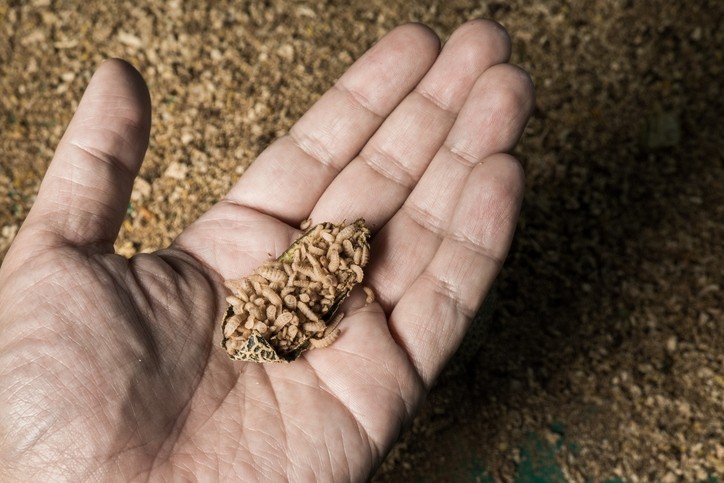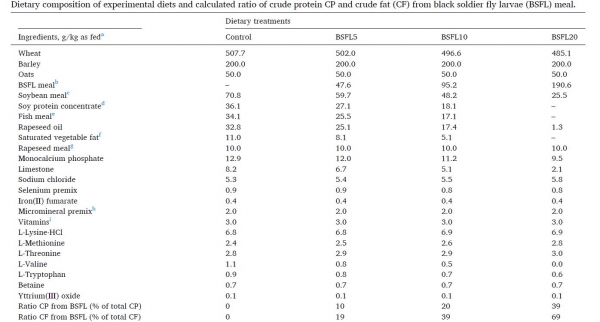Does the use of full-fat insect meal in their diets support gut function and growth of weaned piglets?

There is much interest in the use of insects, such as the black soldier fly larvae (BSFL), as sustainable protein sources for use in pig feed in the EU, particularly as recent legislative developments in the bloc mean the supplementation of feed with such processed animal proteins is now authorized.
In that context, researchers from the Faculty of Biosciences at the Norwegian University of Life Sciences (NMBU) decided to investigate the effect of increased inclusion of full-fat BSFL in diets for post-weaning pigs on growth performance parameters, digestibility of nutrients, gut morphology, and the microbial community in the colon.
The team, writing in Animal Feed Science and Technology, outlined how BSFL contains chitin, medium-chain fatty acids, and antimicrobial peptides, components that could improve the gastrointestinal function and health of the post-weaning pig.
If not defatted, BSFL is high in fat, especially in lauric acid (12:0; Finke, 2013), which is categorized as a medium-chain fatty acid (MCFA) with antimicrobial effects, especially against gram-positive bacteria (Zentek et al., 2011), they said.
"Insects and insect larvae also contain chitin, a dietary polysaccharide that can function as a prebiotic and an immunostimulant (Song et al., 2014). Finally, antimicrobial peptides, which are part of the insect immune system, are effective antimicrobial agents with low risk of development of bacteria resistance (Lewies et al., 2019).
"The antimicrobial peptides have good potential as health promoters in livestock, even though there is limited information about the in vivo effects (Wang et al., 2016).
"Insects are, therefore, interesting to investigate both as a feed ingredient and as a functional ingredient with potential health beneficial effects. Recently, there has been a high focus devoted to the potential of insect meals in diets for monogastric farm animals (J´ozefiak et al., 2018; Spranghers et al., 2018; Biasato et al., 2019; Nogales-M´erida et al., 2019). However, there is a scarcity of literature on the use of full-fat BSFL in diets for pigs," noted the authors.
Margareth Øverland, professor in animal nutrition, at the Norwegian University of Life Sciences (NMBU), and one of the authors of the study, told FeedNavigator about the potential of insect meal for use in monogastrics and fish:
"Insects are interesting because they are an efficient bio-converter of a wide range of waste streams from plant by-products and food waste into valuable novel protein and energy sources for livestock feed. These waste streams do not only represent a large environmental concern, they represent a loss of valuable resources.
"Insects are highly suitable as a feed resource due to their high-quality protein and fat content. In my research team, I have three PhD students working on using insect meal from black solider fly larva in diets for piglets and Atlantic salmon. Results show that insects are a good protein and energy source that support high growth performance and health of piglets during the critical time after weaning and during the juvenile phase of Atlantic salmon rearing.
"The nutritional value of insect meal depends on the substrate used for the production and downstream processing of insects after harvest. Insects also contain bioactive components such as antimicrobial peptides, the short chain lauric acid, and chitin that can have positive health effects such as promoting a health gut microbiota."
Methodology
Their study involved the use of 80 crossbred pigs, which had been weaned at around 32 days of age. There were five pens per treatment with four pigs per pen.
The pigs were fed a control diet or one of three diets containing an increasing amount of full-fat BSFL meal: 4.76%, 9.52%, and 19.06% over four weeks.
Diets were formulated in collaboration with Norwegian feed producer, Felleskjøpet Fôrutvikling, and were formulated based on net energy and coefficients of standardized ileal digestibility (CSID) to be isoenergetic, balanced for digestible amino acids, and to meet or exceed the nutrient requirements of pigs (NRC, 2012). The automatic feeders were checked daily and refilled when needed. Feed residues were registered weekly and average daily feed intake (ADFI) per pen was calculated, reported the team.
Clean drinking water was always available from a drinking nipple next to the feeder, they added.
The findings
Average daily gain (ADG) was highest for pigs fed the control diet and lowest for pigs fed the diet with 4.76% BSFL.
The increased level of full-fat BSFL in the diet did not affect feed efficiency or fecal consistency.
A linear reduction in the coefficient of apparent total tract digestibility (CATTD) of crude protein was found for increasing inclusion of BSFL, whereas, for crude fat, both the coefficient of apparent ileal digestibility and the CATTD increased linearly, reported the researchers.
Jejunal, ileal, or colonic morphometry was not affected by the BSFL inclusion, they noted.
Microbiota population
No differences in the short-chain fatty acid concentrations were detected among the dietary treatments, but the authors observd a few minor changes in the colon microbiota.
“At the phylum level, the colon microbiota was dominated by Bacteroidota and Firmicutes, but there was no clear pattern relationship with the BSFL inclusion level.
“At the genus level, the inclusion of BSFL in the diet reduced the relative abundance of Lactobacillus compared to the control.”
Overall, the results of the study indicated that up to 19.06% of full-fat BSFL meal could be included in a balanced diet for post-weaning pigs with only minor effects on performance results, concluded the researchers.
"Increased inclusion of BSFL decreased the CATTD of CP and increased CATTD of CF but did not affect the general gut function, as assessed by enzyme activity and morphometry. There was a mild to moderate enterocyte vacuolization at the jejunal folder tips in piglets fed insect meal. Some changes in the colon microbiota composition were observed, such as decreased relative abundance of Lactobacillus with dietary inclusion of BSFL. However, there are limited information and contradictive results on the effect of BSFL on the gut microbiome in pigs, thus further investigations are needed."
Source: Animal Feed Science and Technology
DOI: https://doi.org/10.1016/j.anifeedsci.2021.115086
Title: Full-fat insect meal in pelleted diets for weaned piglets: Effects on growth performance, nutrient digestibility, gastrointestinal function, and microbiota
Authors: I Marie Håkenåsen, G Holseth Grepperud, J Øvrum Hansen, R Martinsen Ånestad, M Øverland, L Torunn Mydland

















